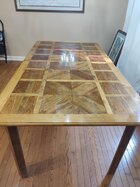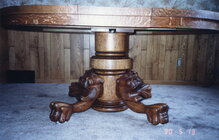Off topic maybe, but I wanted to post here for the most eyes.
Last summer I ordered a kitchen/dining table and 8 chairs from our local Amish community. I just got word that the order is ready for pickup. The pieces will be unfinished. What would you suggest for a finish? I haven't thought about it a lot yet, but my initial thoughts are I'd use a Danish oil like Watco (as opposed to pure PLO) on the chairs and lower parts of the table, and polyurethane on the table surface. Any advice is appreciated.
Edit: The wood is red oak.
I built this cherry and maple table over 30 years ago. It sat in the garage in Vegas for 20 years before we resurrected it to use temporarily in the new house. I recall using many coats of poly, with the last coats being thinned pretty heavily. I had little experience at the time, and the cherry laminate is coming up in places (don't look too closely). Someday I'll redo it.

Last summer I ordered a kitchen/dining table and 8 chairs from our local Amish community. I just got word that the order is ready for pickup. The pieces will be unfinished. What would you suggest for a finish? I haven't thought about it a lot yet, but my initial thoughts are I'd use a Danish oil like Watco (as opposed to pure PLO) on the chairs and lower parts of the table, and polyurethane on the table surface. Any advice is appreciated.
Edit: The wood is red oak.
I built this cherry and maple table over 30 years ago. It sat in the garage in Vegas for 20 years before we resurrected it to use temporarily in the new house. I recall using many coats of poly, with the last coats being thinned pretty heavily. I had little experience at the time, and the cherry laminate is coming up in places (don't look too closely). Someday I'll redo it.

Last edited:

